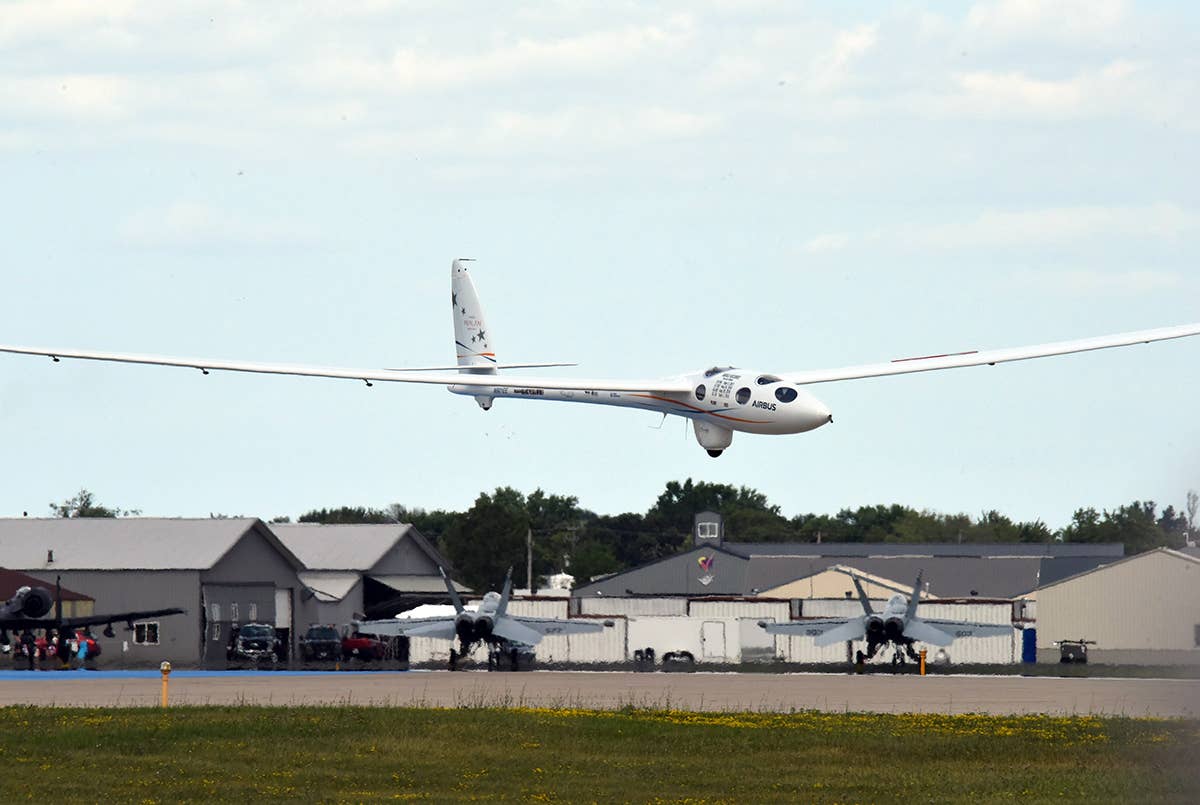Sailplane That Soared Higher Than the U-2 Flies at Oshkosh
Perlan 2, the record-setting, high-altitude glider, performed its first flight demo on Tuesday.

The pressurized, high-altitude Perlan 2 sailplane performed a short flight Tuesday at EAA’s AirVenture in Oshkosh, Wisconsin. [Photo: Thom Patterson]
Perlan 2, the record-setting, pressurized high-altitude glider, performed its first flight demonstration at EAA AirVenture Tuesday, with help from the flight test team’s unique Grob Egrett turboprop.
During previous visits to Oshkosh, Wisconsin, Perlan 2 was featured in the static display, but this year, chief pilot Jim Payne and chief engineer Morgan Sandercock finally took the opportunity to showcase the flight characteristics of this unique sailplane.
In 2018, Perlan 2 made the world’s highest crewed wingborn subsonic flight at 76,124 feet pressure altitude in the Patagonia region of Argentina. Although that height surpassed the maximum recorded altitude in level flight of the legendary Lockheed U-2 Dragon Lady, the SR-71 Blackbird still holds the overall record altitude for level flight of a crewed airplane, at 85,069 feet.
In the hours leading up to Tuesday’s flight, news that the one-of-a-kind glider would be performing drew crowds and long-lens photographers to the flight line observation zone at Wittman Regional Airport (KOSH).
Here we go! Perlan 2 is back and ready for @EAA AirVenture next week.
— Perlan Project (@PerlanProject) July 19, 2022
As Chief Pilot Jim Payne said, “Made two flights to practice for Oshkosh. Despite the 34-month layoff, the Perlan 2 flew as well as ever. It is ready to go!” #AirbusPerlanMission II #OSH22 @AirbusInTheUS pic.twitter.com/FoXtzxEjDC
Shortly before 3 p.m., the Egrett—with glider in tow—taxied down Runway 27 and quickly went airborne, soaring over the airfield against blue skies mixed with scattered clouds.
“It's exciting to show off the airplane,” Payne told FLYING shortly before the flight. “Now, it's not very maneuverable, so we're not going to do any aerobatics. But it offers a chance to see a tow. The Egrett tows are impressive, because it climbs so fast.”
According to aeropedia.com, the maximum rate of climb at sea level for the type is 427 meters per minute (1,400 fpm).
The flight crew uses a 300-foot tow line. During takeoff, Payne said, “we’re basically flying in formation on the end of the rope. The Egrett has such a high climb rate that there’s a high tension on the rope. So it’s actually pretty easy to fly because the glider wants to go where the Egrett goes.” Payne said he planned to limit the aircraft’s altitude during the flight to 1,500 feet.
After a flight lasting less than 15 minutes, the glider coasted in for a smooth landing back on Runway 27. Payne and Sandercock exited the aircraft and sat on its fuselage during the tow back to the EAA’s Boeing Plaza.
Ever wondered what it's like to soar to the edge of #space?
— Perlan Project (@PerlanProject) September 2, 2021
On Sept. 2, 2018, Jim Payne and Tim Gardner with support from a dedicated team of volunteers, soared the engineless Perlan 2 #sailplane to a world altitude record of 76,124 ft.(23,203 m) on #AirbusPerlanMission II. #OTD pic.twitter.com/3koDwfLtjL
About the Aircraft
With an empty weight of 1,500 pounds, Perlan 2 is amazingly light for the structural strength required for stratospheric flight. Its wingspan of 84 feet gives the airplane a total wing area of 262 square feet.
In flight, cabin pressure reaches 8.5 pounds per square inch (psi), creating a cabin atmosphere equal to flight at about 14,000 feet.
As you might guess, flying a glider to high altitudes requires specialized equipment, including dual-redundant oxygen rebreathers. The aircraft has been outfitted with a drogue parachute for rapid descent, if necessary, and a ballistic chute for a lower-altitude emergency descent.
How It Flies
Flying Perlan 2 involves the same piloting techniques commonly used by wave-soaring pilots—leveraging clouds and stratospheric air currents formed by mountain wave effects to gain altitude. When there are no clouds to mark the lift-producing areas, aircraft positioning is done using a GPS-based moving map.
What's Next
Next year, this aircraft—with backing from Airbus—is scheduled to soar higher than it ever has before—to test the glider’s 90,000-feet service ceiling, “We're going back to Argentina to attempt the fly to FL900,” Payne said. “That will be in late July through early September 2023.”
Airbus Perlan Mission II is scheduled to perform research on weather conditions in the upper atmosphere. If successful, the mission will set a world altitude record for crewed wing-borne flight, according to the Perlan website.
“We have some new science payloads we’ll also incorporate into the airplane,” Payne said. “But visually, the airplane is ready to go.”

Subscribe to Our Newsletter
Get the latest FLYING stories delivered directly to your inbox






